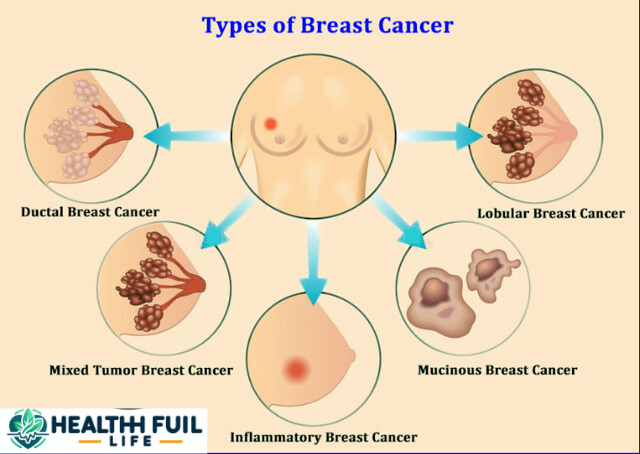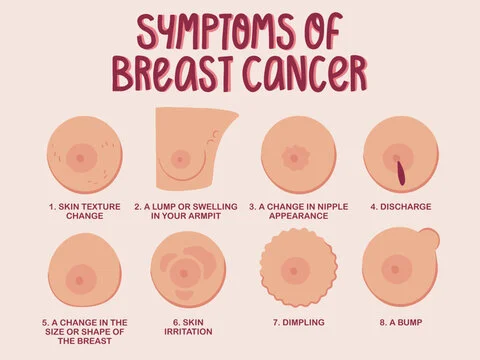Breast Cancer
Breast cancer is a significant health concern affecting millions of women worldwide. It is characterized by the uncontrolled growth of cells within the breast, most commonly in the ducts or lobules. These abnormal cells can form a mass or tumor, detectable through imaging techniques like mammography or physical examinations.
Breast cancer begins when cells in the breast grow out of control. These cells typically form a tumor that can be seen on an x-ray or felt as a lump. The tumor is considered malignant (cancerous) if the cells invade surrounding tissues or spread to distant areas of the body. Breast cancer mostly starts in the ducts that carry milk to the nipple (ductal cancers) and, less commonly, in the glands that make breast milk (lobular cancers).
There are several types of breast cancer. The diagnosis and treatment depend on the specific characteristics of the tumor, including its size, location, and whether it has spread to other parts of the body. Early detection is crucial for successful treatment and improved survival rates.

Key Risk Factors
The strongest risk factor for breast cancer is female gender, with 99% of cases occurring in women. Other risk factors include increasing age, obesity, alcohol consumption, family history of breast cancer, radiation exposure, certain reproductive histories, tobacco use, and postmenopausal hormone therapy.
Global Impact and Mortality Rates
Breast cancer is the most common cancer among women globally, with significant mortality rates. In 2022, it caused approximately 670,000 deaths worldwide. This high mortality rate underscores the urgent need for effective prevention, early detection, and treatment strategies.The prevalence of breast cancer places a substantial burden on healthcare systems.
The need for regular screening, diagnostic procedures, and long-term treatment requires significant medical resources and infrastructure. In many low- and middle-income countries, access to these essential services is limited, exacerbating health disparities and leading to poorer outcomes.
Types of Breast Cancer
There are several types of breast cancer, including:
- Ductal Carcinoma In Situ (DCIS): A non-invasive cancer where cells are confined to the ducts.
- Invasive Ductal Carcinoma (IDC): The most common type, where cancer cells spread beyond the ducts.
- Invasive Lobular Carcinoma (ILC): Begins in the lobules and can spread to other parts of the body.
- Triple-Negative Breast Cancer: A subtype lacking three common receptors known to fuel most breast cancers.
- Inflammatory Breast Cancer: A rare but aggressive form causing red, swollen breasts.

Symptoms of Breast Cancer
Early Symptoms
Early detection of breast cancer significantly increases the chances of successful treatment. Key early symptoms include:
- Lump in the Breast or Underarm: Often the first sign, usually painless.
- Changes in Breast Shape or Size: Unexplained changes may indicate underlying issues.
- Skin Changes: Dimpling, puckering, or redness of the breast skin.
- Nipple Discharge: Especially if bloody or occurring without squeezing.
- Nipple Changes: Inversion or changes in the appearance of the nipple.
Advanced Symptoms
As breast cancer progresses, symptoms may become more pronounced:
- Persistent Pain: In the breast or nipple area.
- Swelling: Of part or all of the breast, even without a lump.
- Enlarged Lymph Nodes: In the armpit or collarbone area.
- Skin Ulceration: Open sores on the breast skin.

Importance of Self-Examination
Regular self-examinations are vital for early detection of various health issues, particularly breast cancer. By performing these checks routinely, individuals can become familiar with their own bodies, making it easier to notice any unusual changes promptly. Understanding what is normal for one’s body enables the identification of anomalies, such as lumps, swellings, or changes in texture, size, or shape, which might be indicative of underlying health problems.
Self-examinations are particularly significant for breast health. Women should be well-acquainted with the normal look and feel of their breasts, which aids in the early detection of any unusual changes.
Regular breast self-examinations involve checking for lumps, thickened areas, or any changes in the breast tissue. While these self-checks should not replace professional screenings and mammograms, they serve as an essential complement, enhancing the overall vigilance towards one’s health.

Key Steps in Performing a Self-Examination
Visual Inspection: Stand in front of a mirror with shoulders straight and arms on the hips. Look for any visible changes in the breasts’ shape, size, or color. Check for any distortion or swelling, and ensure that both breasts are their usual shape and color without visible distortion or swelling.
Physical Inspection: Raise the arms and look for the same changes. Then, with the arms still raised, check for any signs of fluid coming out of one or both nipples. This fluid could be watery, milky, or yellow, or even blood.
Manual Examination While Lying Down: Feel the breasts while lying down, using the opposite hand to breast (right hand for left breast and vice versa). Use a firm, smooth touch with the first few fingers of the hand, keeping the fingers flat and together. Use a circular motion, about the size of a quarter. Cover the entire breast from top to bottom, side to side—from the collarbone to the top of the abdomen, and from the armpit to the cleavage.
Manual Examination While Standing or Sitting: Many women find that the easiest way to feel their breasts is when their skin is wet and slippery, so they prefer to do this step in the shower. Cover the entire breast using the same hand movements described in the lying down portion.

Why Self-Examinations Matter
Early Detection: Early detection of breast cancer can significantly increase the chances of successful treatment. Self-examinations can help catch anomalies early when they are most treatable.
Empowerment: Regular self-examinations empower individuals to take charge of their health. This proactive approach fosters a sense of control and awareness about one’s body. Health Awareness: These self-checks encourage a broader awareness of one’s health, prompting individuals to seek medical advice if they notice changes or abnormalities. Supplement to Professional Screenings: While self-examinations are not a substitute for professional medical screenings, they are a crucial supplement. They bridge the gap between regular healthcare visits, providing an additional layer of vigilance.
Professional Guidance and Support
Healthcare providers can offer guidance on how to perform self-examinations effectively. They can demonstrate the proper techniques and answer any questions. It is important for individuals to report any changes or concerns to a healthcare professional promptly, as they can conduct further evaluations and recommend appropriate diagnostic tests.
In conclusion, self-examinations are a simple yet powerful tool in maintaining health and early detection of issues. By becoming familiar with the normal state of their bodies, individuals can more easily identify any changes that might require medical attention. Regular self-examinations, combined with professional screenings, form a comprehensive approach to health vigilance, ensuring better outcomes and peace of mind.
Diagnosis of Breast Cancer
Screening Methods
Screening aims to detect breast cancer before symptoms appear. The primary screening methods include:
- Mammography: An X-ray of the breast, recommended annually for women over 40.
- Ultrasound: Uses sound waves to produce images, often used alongside mammography.
- Magnetic Resonance Imaging (MRI): Uses magnets and radio waves, beneficial for high-risk women.
Diagnostic Tests
If a screening test indicates abnormalities, further diagnostic tests are conducted:
- Biopsy: The definitive test for diagnosing breast cancer, where tissue samples are examined microscopically.
- Fine-Needle Aspiration (FNA): Uses a thin needle to remove cells or fluid from a suspicious area.
- Core Needle Biopsy: Uses a larger needle to remove tissue samples.
- Surgical Biopsy: Removes a part or all of the suspicious area for examination.
Staging and Grading
After diagnosis, determining the stage and grade of cancer is crucial for treatment planning:
- Staging: Indicates the extent of cancer spread. Stages range from 0 (non-invasive) to IV (metastatic).
- Grading: Describes how much cancer cells resemble normal cells, indicating how quickly the cancer is likely to grow and spread.

The Importance of Early Detection
Survival Rates
Early detection of breast cancer drastically improves survival rates. For example, the five-year survival rate for localized breast cancer (confined to the breast) is 99%, compared to 27% for distant metastatic cancer.
Treatment Options
Treatment options vary depending on the stage and type of breast cancer and may include:
- Surgery: Lumpectomy or mastectomy to remove cancerous tissue.
- Radiation Therapy: Uses high-energy rays to destroy cancer cells.
- Chemotherapy: Involves drugs to kill or slow the growth of cancer cells.
Conclusion
Understanding breast cancer symptoms and diagnosis is crucial in the fight against this pervasive disease. Early detection through regular self-examinations, awareness of the early signs, and adherence to screening recommendations can lead to timely and life-saving interventions. The importance of being proactive and informed cannot be overstated, as early diagnosis significantly improves survival rates and treatment outcomes.
As medical research continues to advance, there is hope for even more effective methods of early detection and treatment. By staying vigilant and taking charge of one’s health, individuals can navigate the challenges of breast cancer with greater confidence and optimism. The collective effort towards awareness, research, and proactive health measures holds the promise of reducing the impact of breast cancer on individuals and society as a whole.

